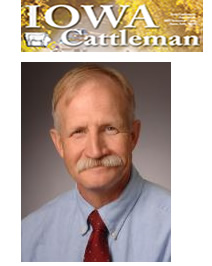Iowa Beef Center director column
August 2022
A recent report (June) from Kansas State University indicated that feed costs of nearly $120 per cwt are just shy of the all-time record of $133 set in March 2013 following the drought of 2012. This is based on data from their “Focus on Feedlots” newsletter. With high feed costs and locally available forages, many cattle producers are looking at other options to reduce cost of gain. Iowa is not well known as a backgrounding state; however, it does traditionally feed more calf -feds vs. yearlings compared to other states. Feeding programs for calves can range from an extended growing period to an accelerated finishing program. The latter is often in an effort to capture seasonally high spring market prices. The decision usually boils down to these four things: feed and forage availability, performance potential of the cattle, market outlook and relative price or value of feeds. We can generalize about strategies to cope with high feed costs but every decision is individual.
Let’s look at an example. At the time of this writing, Iowa corn price is $7.50 per bushel and local hay prices are $120-$150 per ton for average quality legume-grass mix. Modified distillers grains are $110 per ton on average. For the sake of our example, let’s assume we want to compare a growing and finishing ration developed for 700-900 lb. cattle. By using ration development software, we can target gains of 3.8 for a finishing ration and 2.8 for a growing ration. If we include a supplement at the recommended rate, the finishing ration will be $250 per ton and the growing ration will be $160 per ton (dry matter).
Stay with me now. If we look at the projections further, calves will gain over 1 pound per day more on 2.3 pounds less feed (dry matter) on the finishing ration compared to the growing ration. This means total cost of gain still favors the higher grain ration by $20 per cwt even with the higher feed costs. When looking for ration adjustments, increasing the distillers grains inclusion decreased cost of gain in this example. But remember, this is one example.
What’s the takeaway? Every situation is different based on feed cost and arability. Be sure to work closely with your nutritionist. They can help you through your own situation. Also, don’t be afraid to reach out to us at the Iowa Beef Center.
The example used here was developed using the ISU Beef Ration and Nutrition Decision Software tool (BRaNDS) developed by the Iowa Beef Center. The program is available from the ISU Extension Store. If interested, Garland Dahlke, Associate Scientist with the IBC, will be holding two hands-on sessions focused on applied ration balancing techniques using the BRaNDS program at the Hansen Ag Student Learning Center in Ames on August 12 and 18.
In-person Beef Quality Assurance (BQA) and Beef Quality Assurance Transportation (BQAT) are on the books in Western and Northwestern Iowa this month. If your certification for either BQA or BQAT are expiring you may want to take advantage of these opportunities. More sessions may be added so be sure to check the Iowa Beef Industry Council (IBIC) BQA page. The Iowa Beef Center provides this program through a cooperative program led by the IBIC.
As fall arrives, keep an eye out for other educational opportunities through in your area. Programs focused on extending the grazing season, corn silage and winter feeding strategies are being developed.
The IBC at Iowa State University serves as the university’s extension program to cattle producers. Our center comprises a team of faculty and staff from the College of Agriculture and Life Sciences, the College of Veterinary Medicine and Iowa State University Extension and Outreach. We work together to develop and deliver the latest in research-based information to improve the profitability and vitality of Iowa’s beef industry. If you’d like to be notified of updates on progress of research projects or programs that might be coming to your area, please subscribe to our “Growing Beef” newsletter by following the link on our website, www.iowabeefcenter.org. If you have a question, use the “Ask our Experts” link on the website. Also, feel free to call us at 515-294-BEEF or email us at beefcenter@iastate.edu. You can also follow @iowabeefcenter on Twitter, YouTube, Facebook, Instagram and now, AgFuse!

